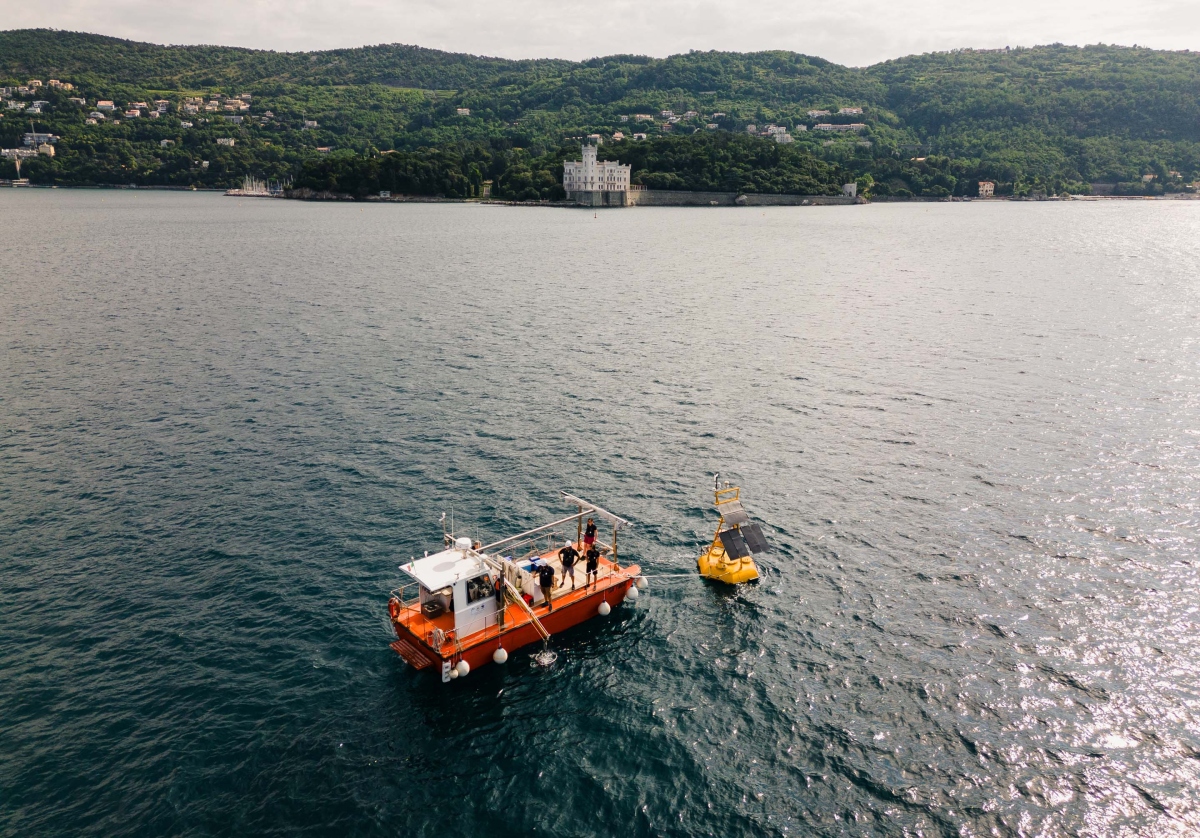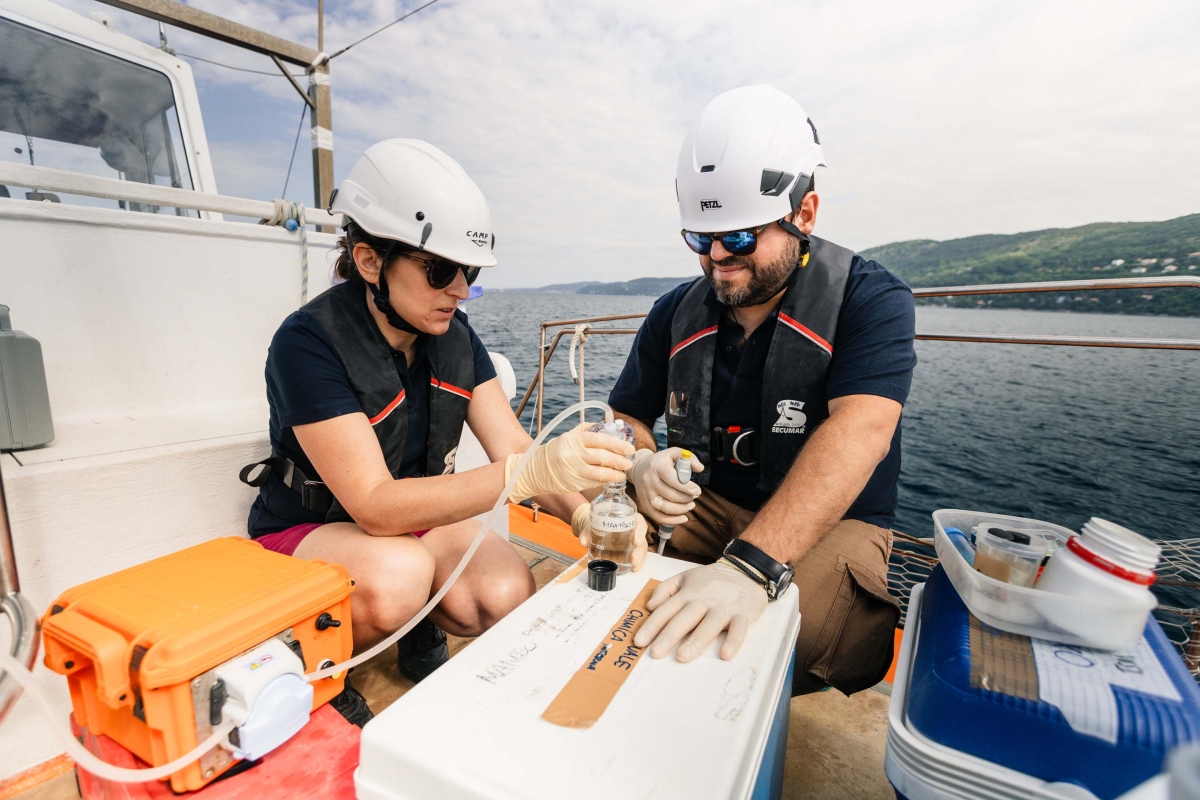
Adjacent to the first Marine Protected Area created in Italy, the Miramare station buoy assists in monitoring ecological and oceanographic processes in the northernmost part of the Adriatic Sea. The station data gives an insight in how marine ecosystems in protected coastal areas respond to the increase of CO2 in the atmosphere.
It is early morning when we arrive in the Miramare harbor, next to the magical Miramare castle cut out from a romantic fairytale. At the edge of a high cliff, the castle is majestically overlooking the sea – and the Miramare buoy is admiringly looking back just under its’ nose. A red-coloured research vessel, that looks like an old-school fishing boat, is waiting for us in the harbor.

from a romantic fairytale.
The five-person research team is joyfully chatting while loading their measurement and sampling equipment on the boat. The water is already splattering in the back of the vessel engine and it is time to go. On our way there, marine bio-geochemist Martina Kralj, gives an overview of the station:
“The buoy is located in the Gulf of Trieste, which is the northernmost part of the Mediterranean sea. It is particular because it is located in a place characterized by river inflows and also by very large temperature variations,” says Martina.

The station is made up of a buoy equipped with sensors for detecting meteorological parameters. The buoy is anchored to the seabed with three anchors and underneath there are sensors for automatic data acquisition, placed at three different depths at 2, 10 and 15 meters.
#ExploreICOS: Investigating marine ecosystems response to increased CO2

Adjacent to the first Marine Protected Area created in Italy, the Miramare station buoy assists in monitoring ecological and oceanographic processes in the northernmost part of the Adriatic Sea. The station data gives an insight in how marine ecosystems in protected coastal areas respond to the increase of CO2 in the atmosphere.
It is early morning when we arrive in the Miramare harbor, next to the magical Miramare castle cut out from a romantic fairytale. At the edge of a high cliff, the castle is majestically overlooking the sea – and the Miramare buoy is admiringly looking back just under its’ nose. A red-coloured research vessel, that looks like an old-school fishing boat, is waiting for us in the harbor.

from a romantic fairytale.
The five-person research team is joyfully chatting while loading their measurement and sampling equipment on the boat. The water is already splattering in the back of the vessel engine and it is time to go. On our way there, marine bio-geochemist Martina Kralj, gives an overview of the station:
“The buoy is located in the Gulf of Trieste, which is the northernmost part of the Mediterranean sea. It is particular because it is located in a place characterized by river inflows and also by very large temperature variations,” says Martina.

The station is made up of a buoy equipped with sensors for detecting meteorological parameters. The buoy is anchored to the seabed with three anchors and underneath there are sensors for automatic data acquisition, placed at three different depths at 2, 10 and 15 meters.

All of a sudden, the yellow buoy with grey solar-like panels and various measurement equipment appears in front of us. We are only a couple of 100 meters from the Miramare castle, proudly posing at the shore, offering splendid views from the buoy together with the green hills covering the whole coastline in the background. Michele Giani, the station PI and marine chemist, catches the buoy using a hook on a stick and the crew rapidly bring out the Niskin sampling bottles placed in a carousel. The device with the bottles is slowly directed into the sea, using a small-scale crane attached on the vessel.
“In this station the main meteorological parameters are measured using automatic sensors: temperature, air humidity, wind direction and intensity, in addition to the partial pressure of carbon dioxide in water, temperature, salinity, pH and dissolved oxygen. Furthermore, measurements are made monthly with discrete sampling using bottles to check the parameters measured by the automatic probes,” says Michele.

Increase of CO2 dissolved in the sea
The Miramare station is not only unique because of its’ picturesque location next to the city of Trieste:
“The depth of the seabed is very limited and therefore is characterized not only by strong temperature variations, but also by possible rises of hypoxic bottom waters in summer or autumn periods, which bring waters poor of oxygen and rich in CO2 to the surface,” Martina explains.
The longer time series of measurements from the station show a clear pattern:
“We have been able to observe an increase in the partial pressure of carbon dioxide dissolved in the sea, which therefore also leads to a decrease in pH in this area. This is partly due to the increase in CO2 in the atmosphere and partly due to the thermal effect of sea warming, which is particularly significant in this area and in the Mediterranean,” Michele adds.
The research team is especially interested in the role of the physical pump which absorbs CO2 in winter and transports it to deep waters, in addition to the role of biological activity which can change with global climate warming.

Mitigation measures effective?
With the sampling bottles filled, we return to the harbor from where we head to the station laboratory on the coastline. Michele and his team use a large set of equipment to examinate the newly collected samples and check the data from the automatic sensors.
“The data coming from the station contributes to provide a European-level picture of CO2 exchanges when analyzing it together with data from other ICOS stations in the network. The data levels show whether the mitigation measures adopted are effective or not,” says Michele and adds:
“For our station it is important to be part of a European network because it places us in an international context in which not only data but also experiences are exchanged. This is useful for improving the measurements and gradually improving the interpretation of what influences the exchange of carbon dioxide between the ocean and the atmosphere in coastal waters.”
Both Michele and Martina are pleased to be a part of the ICOS station network:
“All this data collected can be compared both with data from other stations, but also globally and to obtain details on what is happening both in the sea and in the common atmosphere. It would be fantastic and very useful if this data could be used both at a governmental and international level,” says Martina smiling but with a seriousness in her eyes.

Source: ICOS


